Table of Contents
HIGHLIGHTS OF NAPLES FROM THE CRUISE TERMINAL – Part II
Walking may be the best way to fully appreciate and experience some of the highlights of Naples. For those who want to explore a little deeper this shady and confusing city, here the Part II of the suggested itinerary “Highlights from the Cruise Terminal”: this will help you saving you time and energy while allowing you to discover some of the most spectacular places of Naples you may have missed on you own. Let’s get started!
Plebiscito Square
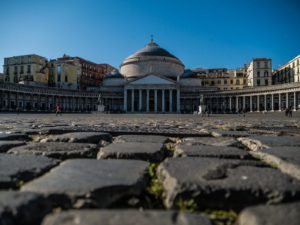
Somewhere in between the bustling shopping street of Toledo and Trieste and Trento Square, Piazza del Plebiscito was and still is the heart of city of Naples. Named after the plebiscite (a kind of national referendum) of 1860 that annexed Naples into the unified Kingdom of Italy, the square once called “Largo di Palazzo” was initially conceived by J. Murat, King of Naples and brother-in-law of Napoleon as a grand tribute to the French emperor. Soon after Napoleon was removed from power and the Bourbons restored to the throne, Ferdinand I completed the project by building the 25,000 square meter open air arena, between the city and the sea, that we see nowadays. Bounded on the east by the Royal Palace and on the west by the church of San Francesco di Paola, Piazza del Plebiscito is the largest of the city of Naples and it often hosts large scale contemporary art installations, temporary exhibitions, cultural events and open-air concerts. It is a must for every tourists visiting the city and a great place to appreciate the magnificent architecture and enjoy the views from the nearby cafes.
Basilica Of San Francesco Di Paola
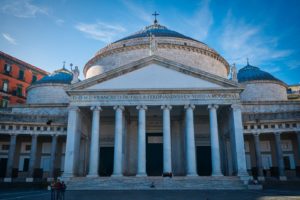 Commissioned by Ferdinand I in 1817 to celebrate the restoration of his kingdom after the Napoleonic interlude, the Basilica of San Francesco di Paola is Naples’ own version of the Roman Pantheon (without the crowds) and a rare example of the Neo-Classical style in town. The church stands in the middle of a hemicycle of 38 Doric columns that dominates Plebiscito Square and its dome is 53 metres high. Just outside the church main entrance there are the equestrian statues of King Charles VII and Ferdinand I of the Bourbon Dynasty.
Commissioned by Ferdinand I in 1817 to celebrate the restoration of his kingdom after the Napoleonic interlude, the Basilica of San Francesco di Paola is Naples’ own version of the Roman Pantheon (without the crowds) and a rare example of the Neo-Classical style in town. The church stands in the middle of a hemicycle of 38 Doric columns that dominates Plebiscito Square and its dome is 53 metres high. Just outside the church main entrance there are the equestrian statues of King Charles VII and Ferdinand I of the Bourbon Dynasty.
Tickets: Free entry
Opening hours: Mon – Sat 08.30 – 19.30.
Royal Palace
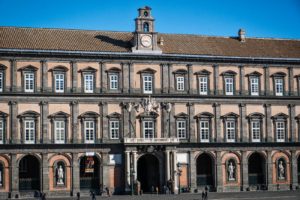 Just in front of the Basilica of San Francesco di Paola, the Royal Palace is one of the most impressive palaces in southern Italy and is ranked among the top highlights of Naples. It was built on the site of an earlier residence erected to accommodate King Philip III of Spain who was supposed to came to visit this part of his kingdom back in XVII century. The architect Domenico Fontana started the construction of the palace in a square plan, with an inner courtyard and the façade overlooking Piazza del Plebiscito. In 1743-48, the palace was enlarged, by the then King of Naples Joachim Murat and his wife Carolina Bonaparte. The building was the official residence of Naples Monarchy, where the Spanish and Austrian viceroy lived, then the Bourbon kings and finally the Savoy family. In 1888, the main façade was decorated with niches containing eight statues of the most important kings of Napoli. Since 1919, it has been possible to visit the Royal Apartments with the King’s apartments, the Throne Hall, the Picture gallery, the Ambassadors Hall, The Queens Apartments and the Palatine Chapel, the Court Theatre and the National Library, which is one of the most important in Europe with its collection of over a million and a half books, medieval palimpsests and codes and the well-known papyrus from Herculaneum.
Just in front of the Basilica of San Francesco di Paola, the Royal Palace is one of the most impressive palaces in southern Italy and is ranked among the top highlights of Naples. It was built on the site of an earlier residence erected to accommodate King Philip III of Spain who was supposed to came to visit this part of his kingdom back in XVII century. The architect Domenico Fontana started the construction of the palace in a square plan, with an inner courtyard and the façade overlooking Piazza del Plebiscito. In 1743-48, the palace was enlarged, by the then King of Naples Joachim Murat and his wife Carolina Bonaparte. The building was the official residence of Naples Monarchy, where the Spanish and Austrian viceroy lived, then the Bourbon kings and finally the Savoy family. In 1888, the main façade was decorated with niches containing eight statues of the most important kings of Napoli. Since 1919, it has been possible to visit the Royal Apartments with the King’s apartments, the Throne Hall, the Picture gallery, the Ambassadors Hall, The Queens Apartments and the Palatine Chapel, the Court Theatre and the National Library, which is one of the most important in Europe with its collection of over a million and a half books, medieval palimpsests and codes and the well-known papyrus from Herculaneum.
Tickets: € 4
Opening hours: Mon – Sun 09.00 – 20.00. (Closed on Wednesday)
Seafront Promenade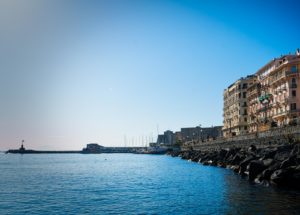
The Seafront Promenade is a popular spot for tourist and locals who aim to relax listening to the Mediterranean Sea gently shattering on the restless rocks. Just beyond Plebiscito Square, the lungomare (as it is called by locals) is a 3km long promenade partially pedestrian that curves along the Bay of Naples from Mergellina district to the Santa Lucia one. Completed in 1893, the lungomare divided in Via Partenope and Via Caracciolo, can be considered the most beautiful urban restoration of the nineteenth century. The area offers a couple of small sandy beaches, bike and boat rental, seaside cafes and restaurants and a breath-taking landscape.
Castle of the Egg
Within walking distance from Plebiscito Square and along the seafront promenade, the citadel known as Castel dell’Ovo was built by the Normans in the 12th century and is Naples’ most ancient castle. Used by the Swabians, Angevins and Alfonso of Aragon, who converted it into a military fortress, the castle stands on the rocky ‘island’ of Megaris, where baded on local folklore, the heartbroken mermaid Parthenope died after failing to seduce Ulysses with her song. It’s also the first Greek settlement of the city back to 7th century BC. Owes its unusual name to the Roman poet Virgil, who, according to the legend, buried an egg beneath the castle, ominously warning that when the egg broke the castle and consequently Naples would fall. Thankfully, both are still standing, and walking up to the castle terraces will reward you with a breath taking view: Mt Vesuvius on one side, and Mergellina harbour on the other with the so famous island of Capri in the distance.
Vittoria Square and Villa Comunale
Piazza della Vittoria commemorates the Battle of Lepanto (1571) and is one of the most important square of the District of Chiaja. It leads inland to the fashionable shopping area of Piazza dei Martiri, Via Chiaia, and Via dei Mille. Piazza Vittoria was part of the restoration plan that took place shortly after the cholera of 1884 and made place for new roads and buildings for the middle and upper class. It hosts the main entrance to the Villa Comunale.
The Villa Comunale is one of the few public gardens of Naples and the only one in the centre of the city. It covers an area of 110,000 square meters and its extension goes from Piazza della Repubblica to Piazza Vittoria. Its construction dates back to 1780, at the behest of King Ferdinand IV of Bourbon, who wanted for himself and for the Neapolitan nobility a promenade and a recreation area. Named Royal Villa, it houses from 1872 the Zoological Station and the Aquarium (the oldest in Europe.
Martyrs’ Square
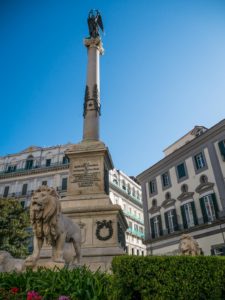
Very close to Piazza Vittoria, Martyr’s Square, another of the highlights of Naples, gets its name from the monument placed at the centre erected to commemorate those who perished during the anti-Bourbon uprisings of 1799, 1820, 1848 and War of unification of 1860 (symbolized by the four lions at the base of the column). The square occupies a place once belonging to the extensive gardens and orchards of the 11th century Abbey of Santa Maria a Cappella, demolished under Joachim Murat in 1812. Martyrs’ square is nowadays a lively area with several stores, historical buildings, elegant shops and cafè. Nearby you can find Via dei Mille with its luxury Italian brands stores.
Chiaja Street and Spanish Quarters
Chiaja Street connects two of the most important shopping areas of the city, Marty’s square and Toledo Street. Lined with shops and restaurants, it underwent initial development in the late 16th and early 17th centuries when the city expanded under the Spanish rulers. Chiaja Streets flanks the well-known Quartieri Spagnoli (Spanish Quarters) that encompass c. 800,000 square metres and consist of a grid of narrow streets and alleys. .Created in the 16th century to house Spanish garrisons, it’s a very folkloristic area that house several artisan shops and wonderful churches.
These highlights of Naples are part of our guided tours Tasting Naples, Discover Naples on foot and Naples Explorer
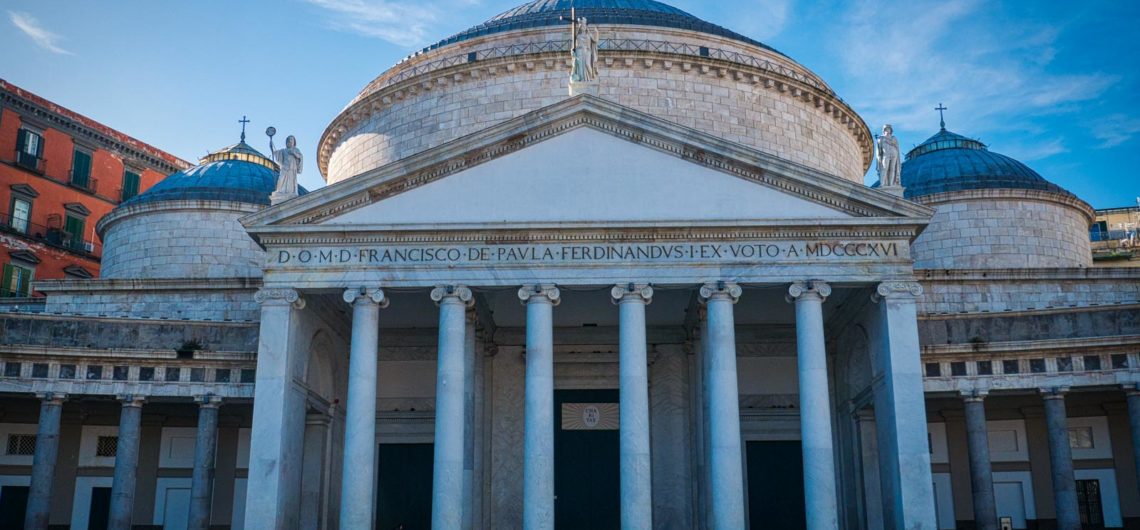
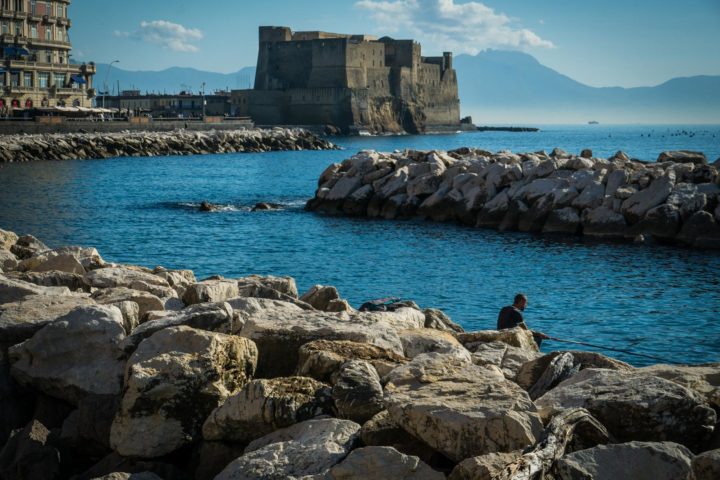
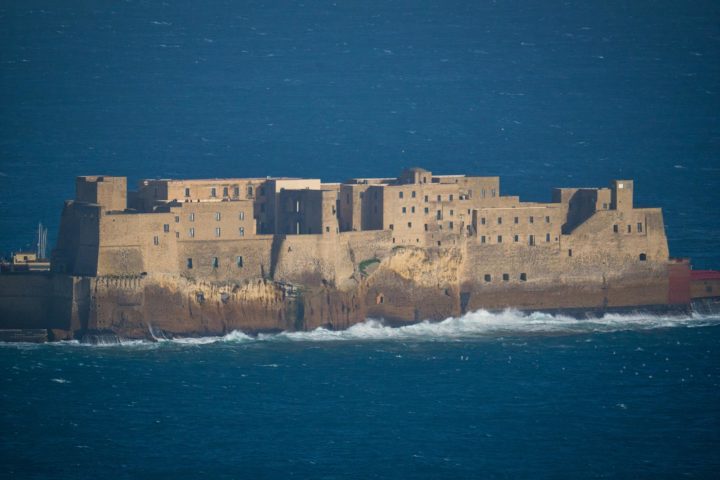
Comments